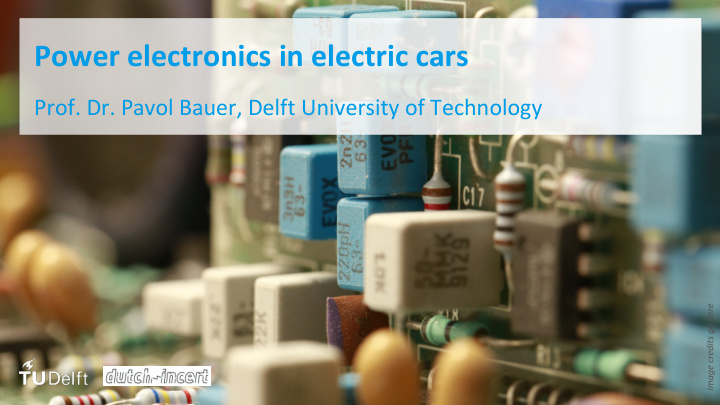



Power electronics in electric cars Prof. Dr. Pavol Bauer, Delft University of Technology Image credits go here
Learning objectives What is a power electronic converter? • Power converter types: • AC or DC o Power flow direction o Isolation o Power converters in an electric car • Four quadrant power converter operation •
Power electronic converter A power electronic converter is an electronic device made of high power semiconductor switches that uses different switching states to change the magnitude and waveform of the voltage and current between the input and output. Power flow i in i o V in INPUT V o OUTPUT control signals
Power electronic switch Image Source: https://www.vfds.com/blog/switching-it-up-igbt
Power converter: AC and DC 1. DC-DC converter Direct Current (DC) 2. DC-AC converter (or) inverter 3. AC-DC converter (or) rectifier 4. AC-AC converters Alternating Current (AC)
Power electronic converter 2. Bidirectional 1. Unidirectional Power flow Power flow i in i o i in i o V in V in V o V o control signals control signals
Power electronic converter 1. Magnetically Isolated 2. Non-isolated Rectifier Inverter
Power converter Type AC or DC AC-DC DC-AC DC-DC AC-AC Magnetic Isolation Isolated Non-isolated Bidirectional power Bidirectional Unidirectional flow
Power converters in electric car Motor drive Auxiliary battery Battery On-board converter converter charger
Power converters in electric car Battery converter, Bidirectional 12V/48V Auxiliary supply On-board charger, Unidirectional Unidirectional converter for converter auxiliary 1 or 3 Phase AC Supply
Power converter Converter AC or DC Isolation Direction On-board charger AC-DC Isolated Unidirectional Battery converter DC-DC Isolated Bidirectional Isolated / Motor drive DC-AC Bidirectional Non-Isolated Auxillary battery Isolated / DC-DC Unidirectional converter Non-Isolated
Four quadrant operation Speed Driving Braking (Forward) 2 1 (Forward) Torque Driving 4 3 Braking (Reverse) (Reverse)
First quadrant operation Speed Driving 1 2 (Forward) Torque Torque 4 3 Rotation speed
Third quadrant operation Speed 2 1 Torque 3 Torque Driving 4 Rotation speed (Reverse)
Third quadrant operation Speed Braking 2 1 (Forward) Torque Torque 3 4 Rotation speed
DC Motor and motor drive operation Current magnitude à Torque magnitude Current direction à Torque direction Voltage magnitude à Rotation speed magnitude Voltage polarity à Rotation speed direction Torque Rotation speed
Four quadrant operation Bidirectional power flow can be achieved by controlling the polarity of voltage and/or current: Voltage, Speed Voltage Speed Current Torque Quadrant + + + + 1 2 1 + + - - 2 Current, 3 4 Torque - - - - 3 - - + + 4
AC and motor drive operation • AC motors more complicated than DC motors • Reverse rotation by changing the connection of the phases • Torque and speed control through control of AC voltage magnitude and frequency Torque Rotation speed
Power electronics in electric cars Prof. Dr. Pavol Bauer, Delft university of Technology Image credits go here
Recommend
More recommend